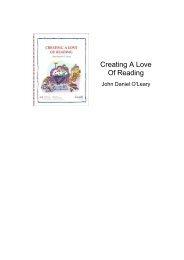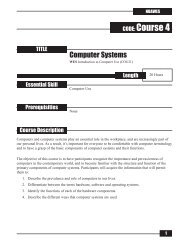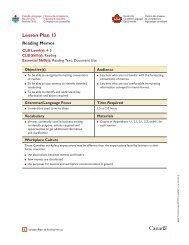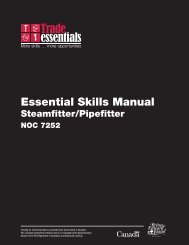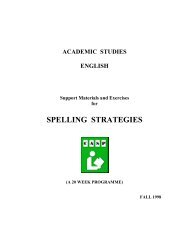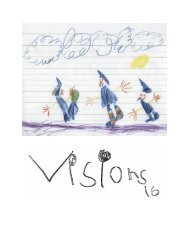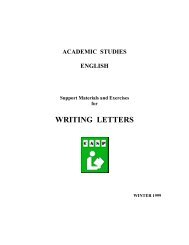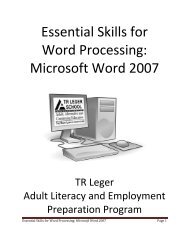Integrating Essential Skills into Training - National Adult Literacy ...
Integrating Essential Skills into Training - National Adult Literacy ...
Integrating Essential Skills into Training - National Adult Literacy ...
You also want an ePaper? Increase the reach of your titles
YUMPU automatically turns print PDFs into web optimized ePapers that Google loves.
EMPLOYABILITY SKILLS AND THEIR RELATIONSHIP TO ESSENTIAL SKILLS<br />
What are Employability <strong>Skills</strong>?<br />
The term Employability <strong>Skills</strong> was coined by the Conference Board of Canada in 1992 to describe<br />
those skills which provide the basic foundation, the combination of skills, attitudes and<br />
behaviours to get, keep and progress on a job, to work with others on a job, and to achieve the<br />
best results (The Conference Board of Canada, Employability <strong>Skills</strong> Profile, 1992). The<br />
Conference Board developed its list of transferable skills from the responses of employers to a<br />
Canada-wide survey. The list includes the added skills employers look for before they hire their<br />
new employees (who already have the required technical skills).<br />
In ensuing years Canadians have come to realize that these skills are the skills needed for much<br />
more than employability. They are, in fact, the generic set of skills that are needed throughout all<br />
career and life development activities. They are not limited in their applicability and may be used<br />
in all environments. The term generic also refers to the transferable nature of these skills.<br />
(Michael R. Bloom and Kurtis G. Kitagawa, Understanding Employability <strong>Skills</strong>, The Conference<br />
Board of Canada, 1999, p.16).<br />
In today’s world there is an increasing need for people to be able to transfer their skills to new and<br />
constantly changing contexts. Therefore, part of the life/work development process must be the<br />
acquisition of skills that can be applied to a variety of situations. These employability skills are<br />
combined in various ways and have several other names, such as: transferable skills, core<br />
competencies, core skills, non-technical skills, essential skills, generic skills, soft skills, basic<br />
skills, and critical workplace competencies. Some people have recently coined the term E <strong>Skills</strong><br />
to describe the broad range of Employability <strong>Skills</strong>, <strong>Essential</strong> <strong>Skills</strong>, Entrepreneurial <strong>Skills</strong> and<br />
Emotional Intelligence.<br />
A key to understanding these generic skills and eliminating the confusion about various labels or<br />
titles is by looking at what people do when they are actually using these skills. Once it is<br />
understood what the skills look like when they are being demonstrated, the actual labels assigned<br />
become less important.<br />
How are <strong>Essential</strong> <strong>Skills</strong> and Employability <strong>Skills</strong> Related?<br />
Human Resources and <strong>Skills</strong> Development Canada (HRSDC) and the Conference Board of<br />
Canada have combined their efforts to show the connection between HRSDC’s <strong>Essential</strong> <strong>Skills</strong><br />
and the Conference Board’s Employability <strong>Skills</strong>. (See attached diagram.)<br />
The Employability <strong>Skills</strong>–<strong>Essential</strong> <strong>Skills</strong> Connection:<br />
• Employability <strong>Skills</strong> and <strong>Essential</strong> <strong>Skills</strong> are, in many ways, the same skills – essential<br />
skills are described from the point of view of competent workers, and the employability<br />
skills, from the point of view of employers.<br />
• The <strong>Essential</strong> <strong>Skills</strong> Research Project (now completed) and the <strong>Essential</strong> <strong>Skills</strong> and<br />
Workplace <strong>Literacy</strong> Initiative (launched in April 2003) examine these skills using a<br />
detailed and systematic approach, and provide information on the different ways these<br />
skills are used in the workplace. The ESRP also provided a way to talk about differences<br />
in how skills are used and differences in the skills people have demonstrated.




